- Home
- Rudy Rucker
Seek!: Selected Nonfiction Page 2
Seek!: Selected Nonfiction Read online
Page 2
When John Oakes of Four Walls Eight Windows agreed to do two anthologies by me, a selected nonfiction and a complete stories anthology, I had the idea to call the first one Seek! and the second one Gnarl! And John liked this idea, he thought it would be nice to have this pair of unexpected, monosyllabic words for the paired book titles. Both my wife Sylvia and my agent Susan Protter mocked me a little, asking if there would be Ye and The volumes, but, no, I don't think so.
I think Seek! makes sense as the name for this collection because seeking is very much something that I've done for my whole life. I've always had a desire to push out to ultimate reality, to discover the Answer, to reach a union with the cosmic One. The nonfiction pieces in Seek! describe some of the various attempts I've made.
I've organized Seek! into three not-quite-mutually-exclusive categories: Science, Life, and Art. Let me briefly summarize the flow of each part.
In the Science part I begin by describing some ways in which I have sought to make computers be interesting and alive. And then, worn down by the mulishness of these machines, I turn to wilder kinds of science speculation.
In the Life part I start by describing some of my old days of pot and beer, get into ideas about God, describe the big move to California, and then include some travel writing. Never am I such a naked seeker as when I'm on the road.
Page 7
In the Art part I discuss my ideas about how to write great science fiction - becoming a good writer has always been my most central quest. I interview one of the founders of my favorite "art religion," the Church of the SubGenius. And I end with essays on new and old visual arts.
One possibly confusing idiosyncrasy of my technique is that when I write about the members of my nuclear family, I prefer to use pseudonyms for them. This is partly so that they feel less exposed, and partly to remind the reader that even though something I write may be presented as an accurate memoir, it's still colored by my fictionalizing tendencies. As will be evident from the context, the transreal names I use for my family members are "Audrey" for my wife, and "Sorrel, Tom and Ida" for our children.
In the Science part of Seek!, I refer to a number of programs that are downloadable from my Web site. This is at www.mathcs.sjsu. edu/faculty/rucker. I'll also maintain a special Seek! page at this site with buttons for the various links which I'm going to mention.
To round out this introductory part of the book, I've included my answers to thirty-seven recent interview questions I've been asked.
Happy seeking!
- RUDY RUCKER, JANUARY 31, 1999.
Page 8
37 Questions
People sometimes contact me to do an interview for various print or electronic publications. I usually prefer doing my interviews by email, both because the written format gives me better control over what I seem to say and because then I have my answers on disk, suitable for reuse. Also it's easy for me and it doesn't take very long. I keep all my old email interviews in a single file and email it to the new interviewer. I encourage them to first read the old questions and answers (which they're also free to use) and to then propose a few new questions of their own.
What we have here is an edited version of my email interviews over the last five years, that is, 19941999. I've gone ahead and updated the answers so as to make them correct as of the time of Seek!'s publication. I've listed each interview under the home of the interviewer, along with the name of the interviewer and of the intended publication.
Tokyo, Japan
From: Nozomi Ohmori
For: Hayakawa SF Magazine
Q1: First of all, I'd like you to tell us something about how you group your novels. In a letter, you categorize The Hacker and the Ants as "transreal autobiography." So, I also want to know whether it makes an interconnected series along with former three novels (The Secret of Life, White Light and The Sex Sphere).
A1: My eleven or twelve novels thus far break into three groups: the Ware tetralogy, the Transreal series, and the Others.
As you mention, The Hacker and the Ants is part of the transreal series which includes The Secret of Life, Spacetime Donuts, and White Light. The Secrete of Life is about me in high school and college. I was a young beatnik freak punk and the objective correlative for this in the book is that I discover that I am in fact from a flying saucer.
Page 9
Spacetime Donuts, the first SF book I wrote, is about my days as a graduate student at Rutgers University in New Brunswick, NJ. Note that the hero, Vernor Maxwell, spends a lot of time in libraries! White Light is about when I was a math prof at SUCAS Geneseo in Genesco, NY. I'll put a little table for you here. I should mention that I didn't write the transreal books in quite the same temporal order as the periods they describe.
TRANSREAL SERIES
"MY" NAME
PERIOD OF MY LIFE
The Secret of Life
"Conrad Bunger"
6367
Spacetime Donuts
"Vernor Maxwell"
6772
White Light
"Felix Rayman"
7278
The Sex Sphere
"Alwin Bitter"
7880
The Hacker and the Ants
"Jerzy Rugby"
8692
Saucer Wisdom
"Rudy Rucker"
9297
And then there's my other six novels:
Ware Tetralogy: Software, Wetware, Freeware, Realware.
Other novels: Master of Space and Time, The Hollow Earth.
It's hard to use the same period of your life twice; a writer's memories are a precious resource that get used up over the course of his or her career.
The transreal novel gap from 19801986 corresponds to my years in Lynchburg, Virginia. I did set a number of transreal short stories in Lynchburg - I usually called it "Killeville." And The Hollow Earth includes some scenes of Lynchburg as well.
Speaking of Lynchburg, one Lynchburg story I never got around to writing would be called "The Men in the Back Room at the Country Club," and it would be about some men who drink and play cards all day every day in the country club locker room, and each evening the black man who takes care of the locker-room puts the men in the steam bath, and all the juice runs out of their bodies, and they're just leathery skins, and he rolls each skin up and places it overnight to pickle in glass-lined golf club bags filled with whisky that's inside of that man's locker. And then in the morning the skins go back into the steam bath and swell up, and there's the platypus honking of the men's
Page 10
hale morning voices. The men aren't supposed to be me, mind you, they're just a Lynchburg image that I never used. If I wrote it, I'd probably tell it from the point of view of a teenage caddy. It could perhaps be a little like Phil Dick's wonderful story, "The Father Thing."
At the start of this answer, I said I'd written "eleven or twelve novels" because one might either classify Saucer Wisdom as a novel or as some new genre such as "fiction nonfiction." I would be most inclined to say Saucer Wisdom really is a transreal novel, but it's written in the form of a nonfiction book about my alleged conversations with a UFO-contactee. It's a novel in somewhat the same sense that Nabokov's Pale Fire is a novel. It has non-central elements that tell a story about the narrator. I got so totally transreal with Saucer Wisdom that I even called "my'' character "Rudy Rucker" instead of making up a different name. I listed all of "my" names in the table up there, just to compare them. As you can see, there's a kind of family resemblance to them.
Q2: When you came to Japan in 1990, you mentioned about the sequel/prequel of Wetware, whose working title was Hardware or Limpware. What is the current situation with your Ware series?
A2: My feeling now is that there will only be four Ware books, making a tetralogy. I've just now finished writing the last one, which gives us Software, Wetware, Freeware, and Realware. It took me nineteen years from the start of Software to the end of Realware! A long time, but that's how much time it ne
eded for me to grow to the point where I could finally resolve all of the relevant issues. I couldn't have done it any faster.
I quit drinking and smoking pot in mid-1996 and my writing speed seems to be picking up. It had been slowing down. Writing Freeware took me two years, from early 1994 to early 1996. Realware took the first eight months of 1998.
There was indeed a time when I occasionally spoke of writing a prequel called Hardware, but my ideas for that book ended up in The Hacker and the Ants. The Hacker and the Ants gives a fairly detailed explanation of how we might use virtual reality and artificial life techniques to get from where we are now to the world of Software, with its intelligent autonomous self-reproducing robots. There also happens to be a Hollywood movie called Hardware, bearing no rela-
Page 11
tion to my books, which is another reason why that wouldn't be a good name for me to use for a novel.
I never really had any intention of writing a book called Limpware, I used to just say that because I didn't want to reveal my actual title too early. In the case of both Freeware and Realware, I wanted to be sure I could actually finish the book before letting people know the title. Limpware is really more of a joke title. Over the years I must have heard every possible joke suggestion for a Ware title. Silverware, underwear, vaporware, nowhere, everywhere - like that. I think four of them is far enough to push it, and now I'm ready to move on. Finis coronat opus.
But you never know. I really like the Ware characters and their world, so I might someday get drawn back into it.
Q3: Can you summarize what is in the four Ware novels?
A3: I could talk about the characters, which is a story in itself, but this time I think I'll stick to the ideas.
There were two main ideas in Software. The first is that we could build some robots which are capable of "reproducing" by building copies of themselves. And if we set a bunch of these robots loose on the moon, evolution could take over, and the self-reproducing robots could evolve to become as intelligent and "conscious" as humans are. The intelligent robots are called "boppers.'' When I thought of this idea in 1979 it was a fairly radical notion. We're more comfortable with it than we used to be.
The second idea in Software is that if we had intelligent robots it might be possible to extract the "software" of a human being's personality and copy this onto a robot body.
The idea in Wetware was to kind of turn the second idea from Software around. Instead of people building robots and putting their minds into robots, the robots build people and put their minds into people. Equality. Break down any human-chauvinistic idea that we're better. The boppers want to prove they're just as powerful as people, so they use "wetware engineering" to build people! And then the boppets find a way to encode their personalities as wetware genetic properties, so that they really can bring into existence a kind of human that has a robot's personality. Wetware is probably the most cyberpunk book I ever wrote, it's quite intense.
Page 12
Nearly ten years of my life went by before I wrote another Ware book, and Software and Wetware were even reissued as a single volume called Live Robots (Avon, 1994).
The thing that pulled me back into the Ware world was that I kept thinking about something that happened at the end of Wetware. The humans exterminate the boppers by means of a biological "chipmold" that ruins their silicon chips. But the boppers had this kind of intelligent plastic for their skins called flickercladding, and the flickercladding became infected with the chipmold and got smarter. I wanted to write more about that stuff.
Freeware starts out in 2053 in Santa Cruz, California. The East and West Coasts of the U.S. have a lot of new citizens called moldies. These are pieces of flickercladding that have chipmold living inside them. Some of the chipmold is psychedelic so you can get severely high by hanging out with a moldie. Moldies are also great for sex, but there is the problem that they are likely to stretch a tendril up your nose, punch through the weak spot near the eye and put a "thinking cap" in your head. Nevertheless, there's a Moldie Citizenship Act that makes them citizens.
One important thing in Freeware is the introduction of a universal communication device called an "uvvy." It's pronounced soft, as if to rhyme with "lovey-dovey." Every SF writer dreams of having one of his or her inventions become "real" - think of Heinlein's "waldo" or Gibson's "cyberspace.'' I have a certain amount of hope pinned on "uvvy." A cell-phone is something like an uvvy.
Another big idea in Freeware is that aliens travel from planet to planet in the form of cosmic rays. And it turns out that the moldies develop a kind of program that enables them to decrypt the alien personality waves. It's a little like downloading a compressed file from the Web and then uncompressing the file onto your computer. It doesn't cost you anything; it's "freeware." But it turns out that the alien freeware completely takes over any moldie that decrypts it. In other words, some of the moldies get turned into aliens. There's some fighting, and all but one of the aliens is killed.
So then I had to write one more Ware book to find out what happened to that last alien, whose name is Shimmer. Shimmer decrypts a few more of the alien personality waves, so in Realware there's
Page 13
actually seven of the aliens. They're all from the same place this time around, a world called "Metamars." They give the human race this amazing tool called an "alla." What the alia does is to make whatever object you describe to it. Like if you have a computer and you do a drawing, you can press "Print" and the drawing comes out. But if you have an alla, you specify something and you say ''Actualize" and the object appears. It's realware. At this point I think I reach the ultimate abstraction of reality into information, which is a theme I've been aiming at throughout all four Ware books.
As well as the play of ideas, there's some emotional themes that run through the Ware books. One of the main themes has to do with how a man comes to terms with his father; and how a father comes to terms with his son. There's a transreal element to the Ware books - especially Software - in that there's a character named Cobb Anderson who's closely modeled on my father. My father had coronary bypass surgery right before I wrote Software, and it had a big effect on his personality - it was almost like he'd gotten a new body. At the end of Realware I feel like I've finally come to terms with my father, and with our interactions, and with his death from a stroke in 1994. It's a liberating feeling to have the Ware tetralogy all done.
Q4: You have cooperated with various SF writers so far. Generally, how the collaboration is done? Using email or phone? For an example, please tell the story about the process of writing "Big Jelly" with Bruce Sterling.
A4: Each collaboration is different, even with the same guy. I write something, send a printout and a copy of the file to the other guy, he adds new stuff and doesn't fuck with my part too much, and then he sends me back the new printout and a copy of the new file. In practice the other writer will tend to change my text and I change his, and we write flaming letters about hands off this and that or put this or that back. It's great fun, as usually writing is an extremely isolated activity.
One way that I sometimes organize writing with a friend is that each of us is responsible for one character who is a transreal representative of the responsible author. A role the author is playing. And then your character can be challenging or running head-trips on your part-
Page 14
ner's character. That can be another element in an SF collaboration, the trying to amuse or to outrage your partner. And then they turn around and do something that really surprises you, and it's fun.

 Million Mile Road Trip
Million Mile Road Trip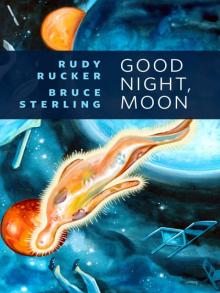 Good Night, Moon
Good Night, Moon Transreal Trilogy: Secret of Life, White Light, Saucer Wisdom
Transreal Trilogy: Secret of Life, White Light, Saucer Wisdom Complete Stories
Complete Stories The Sex Sphere
The Sex Sphere Surfing the Gnarl
Surfing the Gnarl Software
Software Mathematicians in Love
Mathematicians in Love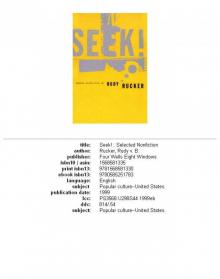 Seek!: Selected Nonfiction
Seek!: Selected Nonfiction The Secret of Life
The Secret of Life The Hacker and the Ants
The Hacker and the Ants Postsingular
Postsingular Spaceland
Spaceland Transreal Cyberpunk
Transreal Cyberpunk Sex Sphere
Sex Sphere Spacetime Donuts
Spacetime Donuts Freeware
Freeware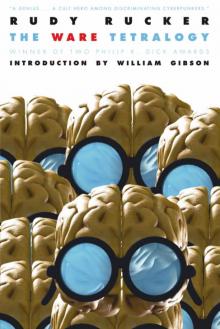 The Ware Tetralogy
The Ware Tetralogy Frek and the Elixir
Frek and the Elixir Junk DNA
Junk DNA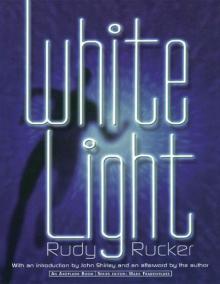 White Light (Axoplasm Books)
White Light (Axoplasm Books) Nested Scrolls
Nested Scrolls Inside Out
Inside Out Where the Lost Things Are
Where the Lost Things Are Mad Professor
Mad Professor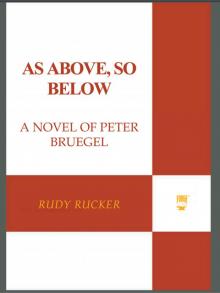 As Above, So Below
As Above, So Below Realware
Realware Jim and the Flims
Jim and the Flims Master of Space and Time
Master of Space and Time The Big Aha
The Big Aha Hylozoic
Hylozoic